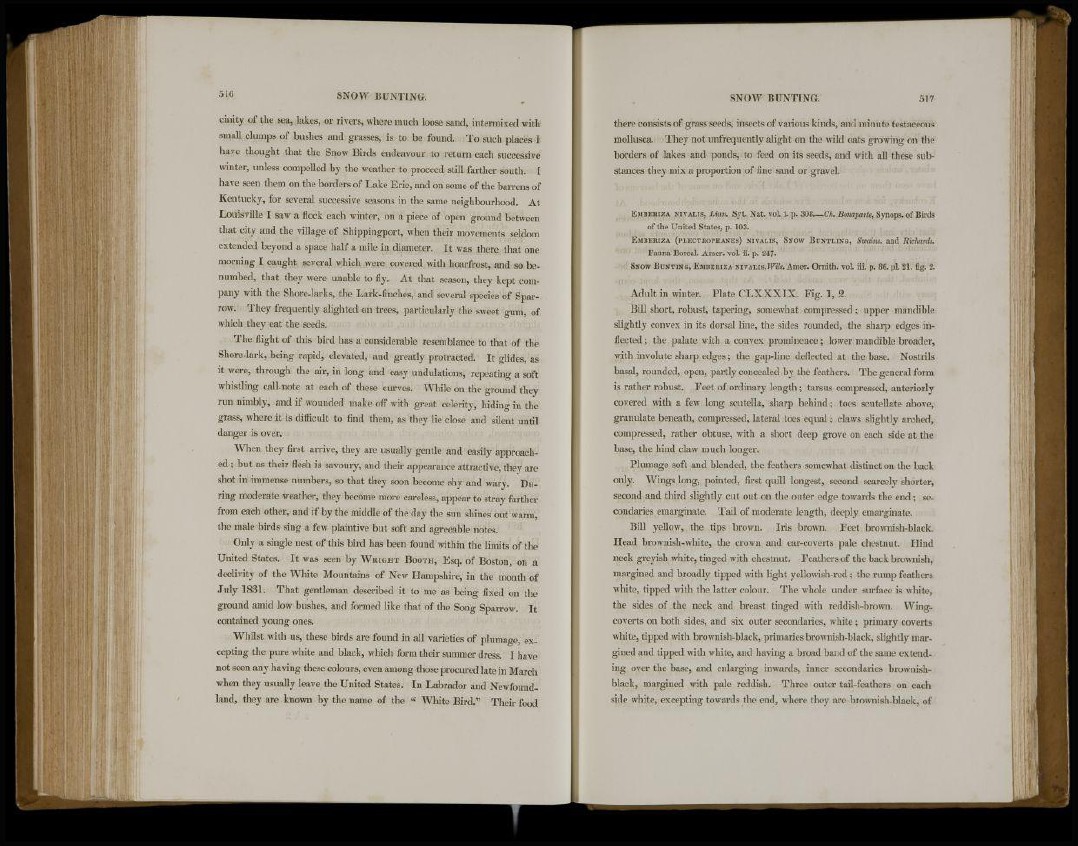
516 SNOW BUNTING.
cinity of the sea, lakes, or rivers, where much loose sand, intermixed with
small clumps of bushes and grasses, is to be found. To such places I
have thought that the Snow Birds endeavour to return each successive
winter, unless compelled by the weather to proceed still farther south. I
have seen them on the borders of Lake Erie, and on some of the barrens of
Kentucky, for several successive seasons in the same neighbourhood. At
Louisville I saw a flock each winter, on a piece of open ground between
that city and the village of Shippingport, when their movements seldom
extended beyond a space half a mile in diameter. It was there that one
morning I caught several which were covered with hoarfrost, and so benumbed,
that they were unable to fly. At that season, they kept company
with the Shore-larks, the Lark-finches, and several species of Sparrow.
They frequently alighted on trees, particularly the sweet gum, of
which they eat the seeds.
The flight of this bird has a considerable resemblance to that of the
Shore-lark, being rapid, elevated, and greatly protracted. It glides, as
it were, through the air, in long and easy undulations, repeating a soft
whistling call-note at each of these curves. While on the ground they
run nimbly, and if wounded make off with great celerity, hiding in the
grass, where it is difficult to find them, as they lie close and silent until
danger is over.
When they first arrive, they are usually gentle and easily approached
; but as their flesh is savoury, and their appearance attractive, they are
shot in immense numbers, so that they soon become shy and wary. During
moderate weather, they become more careless, appear to stray farther
from each other, and if by the middle of the day the sun shines out warm,
the male birds sing a few plaintive but soft and agreeable notes.
Only a single nest of this bird has been found within the limits of the
United States. It was seen by WRIGHT BOOTH, Esq. of Boston, on a
declivity of the White Mountains of New Hampshire, in the month of
July 1 8 3 1 . That gentleman described it to me as being fixed on the
ground amid low bushes, and formed like that of the Song Sparrow. It
contained young ones.
Whilst with us, these birds are found in all varieties of plumage, excepting
the pure white and black, which form their summer dress. I have
not seen any having these colours, even among those procured late in March
when they usually leave the United States. In Labrador and Newfoundland,
they are known by the name of the " White Bird." Their food
SNOW BUNTING. 5 1 7
there consists of grass seeds, insects of various kinds, and minute testaceous
mollusca. They not unfrequently alight on the wild oats growing on the
borders of lakes and ponds, to feed on its seeds, and with all these substances
they mix a proportion of fine sand or gravel.
EMBERIZA NIVALIS, Linn. Syt. Nat. vol. i. p. 308.—Ch. Bonaparte, Synops. of Birds
of the United States, p. 103.
EMBERIZA (PLECTROPHANES) NIVALIS, SNOW BUNTLING, Swains, and Richards.
Fauna Boreal. Amer. vol. ii. p. 247-
SNOW BUNTING, EMBERIZA NIVALIS, Wils. Amer. Ornith. vol. iii. p. 8G. pi. 21. fig. 2.
Adult in winter. Plate CLXXXIX. Fig. 1 , 2.
Bill short, robust, tapering, somewhat compressed; upper mandible
slightly convex in its dorsal line, the sides rounded, the sharp edges inflected
; the palate with a convex prominence; lower mandible broader,
with involute sharp edges; the gap-line deflected at the base. Nostrils
basal, rounded, open, partly concealed by the feathers. The general form
is rather robust. Feet of ordinary length; tarsus compressed, anteriorly
covered with a few long scutella, sharp behind; toes scutellate above,
granulate beneath, compressed, lateral toes equal; claws slightly arched,
compressed, rather obtuse, with a short deep grove on each side at the
base, the hind claw much longer.
Plumage soft and blended, the feathers somewhat distinct on the back
only. Wings long, pointed, first quill longest, second scarcely shorter,
second and third slightly cut out on the outer edge towards the end; secondaries
emarginate. Tail of moderate length, deeply emarginate.
Bill yellow, the tips brown. Iris brown. Feet brownish-black.
Head brownish-white, the crown and ear-coverts pale chestnut. Hind
neck greyish white, tinged with chestnut. Feathers of the back brownish,
margined and broadly tipped with light yellowish-red; the rump feathers
white, tipped with the latter colour. The whole under surface is white,
the sides of the neck and breast tinged with reddish-brown. Wingcoverts
on both sides, and six outer secondaries, white; primary coverts
white, tipped with brownish-black, primaries brownish-black, slightly margined
and tipped with white, and having a broad band of the same extending
over the base, and enlarging inwards, inner secondaries brownishblack,
margined with pale reddish. Three outer tail-feathers on each
side white, excepting towards the end, where they are brownish-black, of